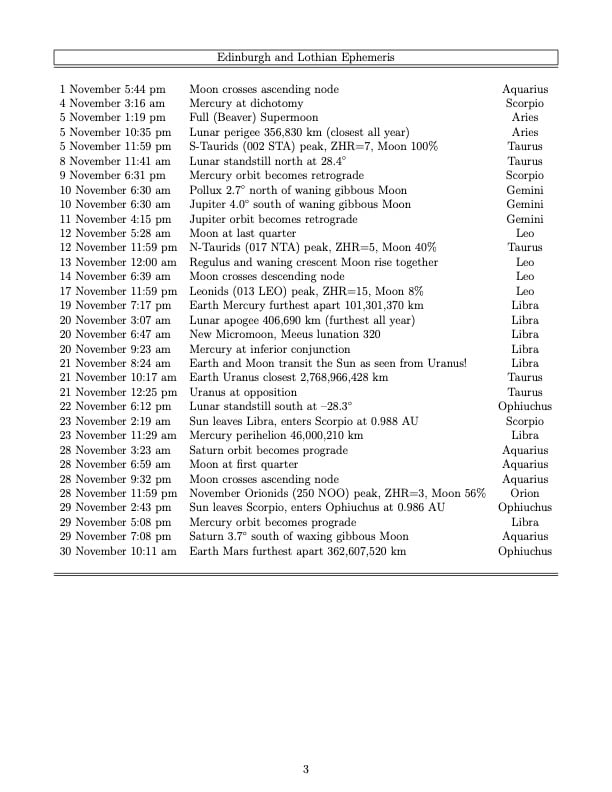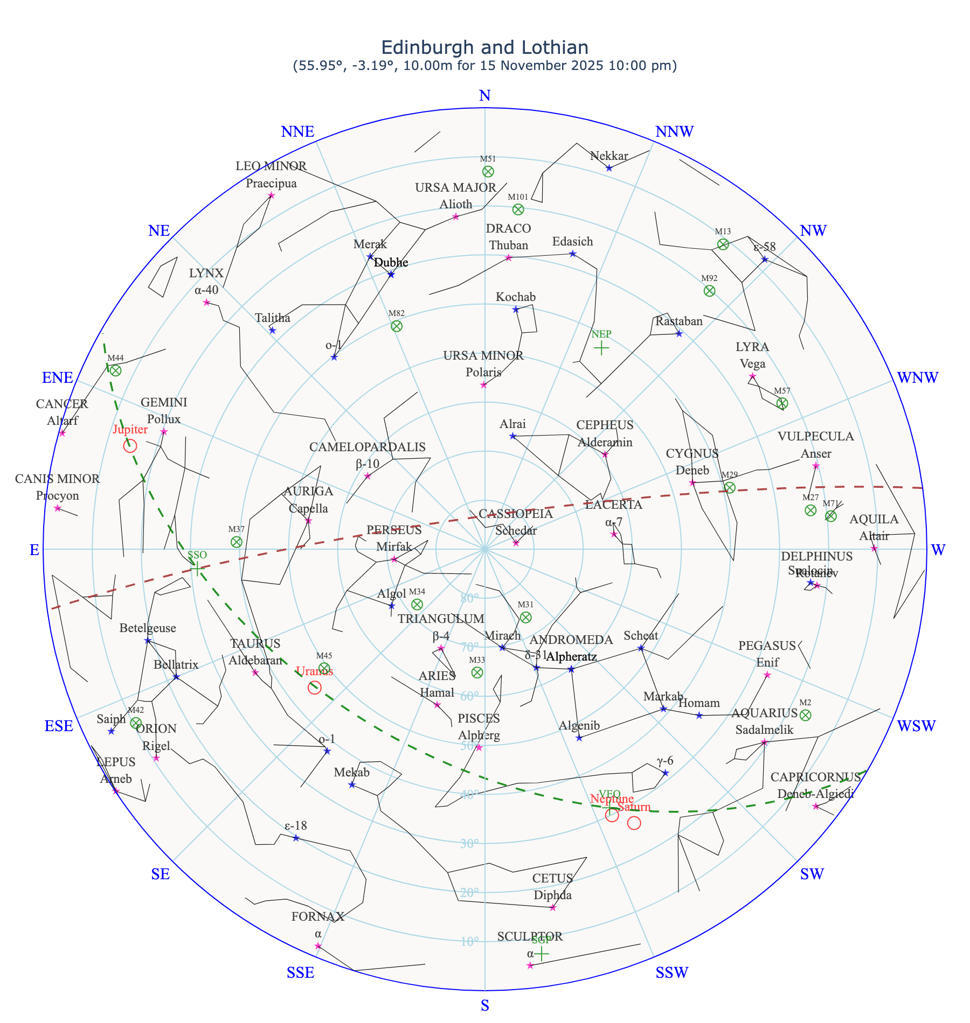November witnesses the largest supermoon, the smallest micromoon and the Sun passing through 2 constellations.
The Sun leaves Libra (The Scales) on 23 November at 2:19 am and enters Scorpius
(The Scorpion). The Sun does not dwell in this constellation, however, but
leaves Scorpius (The Scorpion) and enters Ophiuchus (The Serpent Bearer) on 29
November at 2:43 pm. Over the course of the month, the Sun comes closer to
Earth by 967,881 km. Daylight shortens from 09:12 (9.198 hours) on 1 November
to 07:27 (7.444 hours) on 30 November so we gain 1 hour and 45 minutes of
night time by month’s end.
The Moon begins the month in Aquarius (The Water Bearer) and ends in Pisces
(The Fishes) coming closer to Earth by 9,290 km. The full Beaver Moon appears
first on 5 November at 1:19 pm in Aries (The Ram). Since it is at ‘perigee
syzygy’, it is also a supermoon and will, in fact, be the closest and largest
supermoon of the year. Lunar perigee (closest to Earth) on 5 November at 10:35
pm finds the Moon some 356,830 km away from Earth—around 27,570 km closer
than average—subtending an angle of 33.5 arc-minutes. This is followed by
last quarter on 12 November at 5:28 am in Leo (The Lion). Lunar apogee
(furthest from Earth) occurs on 20 November at 3:07 am and takes the Moon to
406,690 km away from Earth—around 22,290 km further than average—subtending
an angle of 29.4 arc-minutes. The new Moon appears on 20 November at 6:47 am in
Libra (The Scales) beginning a new synodic (Lunar) month which will last 29
days, 18 hours and 56 minutes. Since the new Moon is at ‘apogee syzygy’, it is
also a micromoon and will, in fact, be the furthest and smallest micromoon of
the year. Finally, the first quarter of the new Lunar cycle shows up on 28
November at 6:59 am in Aquarius (The Water Bearer).
On 10 November, in the pre-dawn hours, we will find the waning gibbous Moon
suspended between Pollux and Jupiter in Gemini (The Twins) in the south-west
with Venus creeping over the horizon in the east. On 13 November, Regulus in
Leo (The Lion) will rise with the waning crescent Moon just after midnight.
Lastly, on 29 November, after sunset, Saturn will be 3.7 degrees south of the
waxing gibbous Moon.
For the inferior planets: Mercury begins the month in Scorpio (The Scorpion)
and ends in Libra (The Scales) but comes closer by 19,849,505 km (0.13AU). The
‘Swift Planet’ reaches dichotomy on 4 November when exactly half of the surface
will be illuminated by the Sun. The following day, Mercury will reach the peak
altitude in the evening sky above Edinburgh and Lothian but will still be
annoyingly close to the horizon. Mercury appears to reverse orbit to retrograde
on 9 November. On 19 November the Earth and Mercury will be furthest apart and,
the next day, Mercury is lost in the Sun’s glare at inferior conjunction. On 23
November, Mercury will be at perihelion (closest to the Sun). On 29 Mercury
returns to a prograde orbit. Venus begins the month in Virgo (The Maiden) and
ends in Libra (The Scales) but recedes by 9,818,073 km (0.06AU). Such a modest
distance barely affects the brightness across November.
For the superior planets: Mars begins the month in Libra (The Scales) and ends
in Ophiuchus (The Serpent Bearer) but recedes by 2,213,754 km (0.02AU). Mars
increases in magnitude from 1.46 to 1.31 (1.15 times in brightness) over the
month. The ‘Red Planet’ will be furthest from Earth on 30 November. Jupiter
remains in Gemini (The Twins) all month but comes closer by 59,848,529 km
(0.39AU). Jupiter increases in magnitude from -2.32 to -2.54 (1.22 times in
brightness) over the month. The ‘Red Giant’ conjuncts with the Moon on 10
November and changes orbit to (apparent) retrograde on 11 November.
Saturn remains in Aquarius (The Water Bearer) all month but recedes by
62,674,413 km (0.42AU). Saturn decreases in magnitude from 0.77 to 0.91 (1.14
times in brightness) over the month. The ‘Ringed Planet’ ends retrograde motion
and returns to prograde on 28 November. Uranus remains in Taurus (The Bull) all
month but comes closer by 7,468,539 km (0.06AU). The ‘Green Giant’ reaches
opposition on 21 November when it will be closest to the Earth and will be
highly suitable to binocular or telescope observation. If we were to exchange
places with observers on Uranus on that date, however, we would see Earth
transit the Sun starting at 8:24 am and finishing at 4:05 pm! The Moon would
transit, too, lagging behind the Earth by 10 minutes or so. Neptune remains in
Pisces (The Fishes) all month but recedes by 62,731,123 km (0.42AU).
The Southern Taurids (002 STA) meteor shower, peaking on Guy Fawkes night, will
be a bust because of the full Moon. We fare a little better with the Northern
Taurids (017 NTA), peaking on 12 November. The radiant is near M45 (The
Pleiades) and the waning crescent Moon will be 40% illuminated. The parent
comet is 2P/Encke, co-discovered by Mechain and Messier in 1786, is named
after the astronomer who first calculated the body’s orbit.
The Leonids (013 LEO) peak on 17 November with an optimistic ZHR of 15. The
waning crescent Moon illumination is low at 8% so it is worth a look. The
radiant point is near Algieba in Leo (The Lion) and the parent comet is
55P/Tempel-Tuttle discovered in 1865. Finally, the November Orionids (250 NOO)
peak on 28 November when the waxing gibbous Moon is 56% illuminated. These are
the secondary meteors seeded by Halley’s comet so activity is low with a ZHR=3.
If predictions are accurate, comet C/2025 A6 (Lemmon) should remain at
naked-eye visibiity for the first fortnight of November.
Look towards Ophiuchus (The Serpent Bearer) an hour after sunset. Even if it
fades from naked-eye view, it should still be
observable with a telescope or binoculars.
At the time of our sky map, some constellations visible are Cassiopeia (The
Seated Queen) at zenith, Ursa Major (The Great Bear) in the north, Auriga (The
Charioteer) in the east, Aquila (The Eagle) in the west and Cetus (The Sea
Monster) in the south. The ecliptic hosts Cancer (The Crab), Gemini (The
Twins), Taurus (The Bull), Aries (The Ram), Pisces (The Fishes), Aquarius (The
Water Bearer) and Capricorn (The Sea Goat).
The ‘Summer Triangle’—Vega in Lyra (The Lyre), Altair in Aquila (The Eagle)
and Deneb in Cygnus (The Swan)—is prominent in the west. The ‘Winter
Triangle’—Procyon in Canis Minor (The Lesser Dog), Sirius in Canis Major (The
Greater Dog) and Betelgeuse in Orion (The Hunter) rises before midnight in the
east. The ‘Winter Hexagon’ (Sirius, Rigel, Aldebaran, Capella, Pollux and
Procyon) rises at the same time. Circumpolar constellations—always above the
horizon—include Camelopardalis (The Giraffe) and Draco (The Dragon).


 Same image as above – but bigger!
Same image as above – but bigger!
Phil Daly is a former employee of the Royal Observatory Edinburgh (now UKATC) on Blackford Hill.
He has worked on the UK’s overseas telescopes in Hawaii (UKIRT, JCMT) and on large telescopes
at major astronomical observatories worldwide. He is currently part of an international collaboration
searching for optical counterparts to gravity wave events using multi-messenger astronomy.
Like this:
Like Loading…
Related
